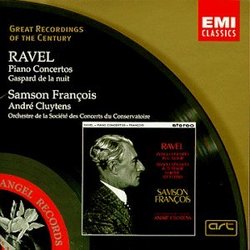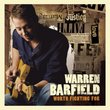| All Artists: Maurice Ravel, André Cluytens, Paris Conservatory Concert Society Orch, piano Samson Francois Title: Piano Concertos / Gaspard De La Nuit Members Wishing: 0 Total Copies: 0 Label: EMI Classics Release Date: 1/12/1999 Album Type: Original recording remastered Genre: Classical Styles: Opera & Classical Vocal, Forms & Genres, Concertos, Historical Periods, Baroque (c.1600-1750), Modern, 20th, & 21st Century, Symphonies Number of Discs: 1 SwapaCD Credits: 1 UPCs: 724356695726, 724356695726 |
Search - Maurice Ravel, André Cluytens, Paris Conservatory Concert Society Orch :: Piano Concertos / Gaspard De La Nuit
 | Maurice Ravel, André Cluytens, Paris Conservatory Concert Society Orch Piano Concertos / Gaspard De La Nuit Genre: Classical Precisely why Samson François is not better known in the United States (or known at all for that matter) is a mystery. On this CD he plays Ravel with absolute mastery, refusing to prettify any of the jazz rhythms in t... more » |
Larger Image |
CD DetailsSynopsis
Amazon.com Precisely why Samson François is not better known in the United States (or known at all for that matter) is a mystery. On this CD he plays Ravel with absolute mastery, refusing to prettify any of the jazz rhythms in the G major concerto, and by so doing, bringing out all of its toughness. There may be impressionism in this music, but there's plenty more, too. François gives the Concerto for Left Hand a performance filled with passion and excitement; indeed it's just this side of abandon. His Gaspard is full of the colors Ravel imbued it with as well. André Cluytens is the ideal leader for this type of music, and while his orchestra here is hardly world class, it's very good. And the remastered sound is excellent. --Robert Levine Similarly Requested CDs
|
CD ReviewsAn Evening with Ravel Robin Friedman | Washington, D.C. United States | 09/14/2005 (5 out of 5 stars) "I was pleased to have the opportunity to get to know better Ravel's piano concertos and an outstanding if eccentric French pianist, Samson Francois (1924 --1970). This CD is a reissue on the EMI "Great Recordings of the Century" series of music first recorded in 1960. In the concertos, Andre Cluytens conducts the Orchestre de la Societe des Concerts du Conservatoire. Ravel wrote his two concertos in the early 1930s following a trip to the United States. He was much taken with American jazz and with the music of George Gershwin, and his fascination with American music is reflected in the first piano concerto in G major. Francois plays throughout with a lively, jazzy feel and with great technique. The orchestral part is highly rhythmical (Listen to the castanets!) and disjointed with the piano writing well integrated and, in its arpeggios and filigree, acting as a counterweight to the orchesta. Ravel was a master of orchestration, and their are lovely solos for winds, percussion and harp. The slow movement of this concerto is all piano. It consists of a plaintive, slow, long-lined piano solo which develops a blusey feel as it proceeds. Ravel is said to have composed this movement with the score of the slow movement of Mozart's clarinet quintet in front of him, as a model for restrained yet deep expression and simplicity. The finale returns to extroverted jazzy music with passages for brass, winds, and snare drum. The piano solo is full of swirling passages in a quick, swing rhythm. Ravel's second concerto in D "for the left hand" is much more somber in tone. The work was commissioned by pianist Paul Wittgenstein who lost his right arm during WW I. Ravel and Wittgenstein subsequently had near-falling out as the composer believed that Wittgenstein took too many liberties with the score. Fortunately Wittgenstein and Ravel worked out a compromise. This is a one-movement work of about 20 minutes which places great demands on the soloist. The piano writing is virtuosic in the extreme, with long arpeggios, huge chords in the piano's lower register, extended solo passages, and leaps from one part of the keyboard to the other. There are also some brilliant glissandos at key points in the music. The piece begins slowly, works to a crescendo in the orchestra, followed by long, rhapsodic writing for the piano. Mid-way, a rather odd march theme begins in the orchestra which again is developed with an overpowering piano part. The piano part throughout this concerto features long, unaccompanied, difficult writing and is uncommonly naked and exposed. The final work on this CD, the solo piano suite "Gaspard de la Nuit" dates from 1908. It is a work of romanticism based upon three poems by Aloysius Bertrand (1807 -1841). Ravel had a fascination with the nocturnal, the mysterious, and the evil, as reflected in Bertrand and in the work of his American contemporary, Edgar Allen Poe. Ravel began with the idea of writing a parody of Bertrand but fell in with the mood of the poems in spite of himself. He composed one of the most romantic and difficult works in the piano literature. The opening movement "Ondine" is the tale of a water nymph looking for a human lover. It is played quietly in the piano's upper register with a great deal of filigree. A slow and shimmery melody sings forth in the middle of the piano. The second movement "gibet" tells a macabre tale of a condemned man swinging on the gallows. Ravel's music features a repeated note throughout which is surrounded by a funereal theme in the low bass. The finale, Scarbo, tells the story of a wicked goblin, who appears from nowhere, works himself into a furious and extended climax, and then disappears. This was something of a signature piece for Francois and he captures the goblin in all its ferocity. Francois was a romantic and idiosyncratic pianist who did not hestitate to take liberties with the score. (Remember the dispute between Paul Wittgenstein and Ravel discussed above.) In the 19th Century, it was often accepted that the performer would bring his own ideas and interpretations to bear upon a work, even when those differed from the composer's markings. Modern practice tends to be far more restrained and textually committed in this regard. Thus, Francois's playing and interpretations are controversial. It is good to be reminded that there are choices to be made in the interpretation of music and that there are legitimate alternatives in performance practice. In this CD, I found that Francois played with eclat and feeling. The first concerto felt jazzy, the second virtuosic and brilliant, and Gaspard de la Nuit mysterious and atmospheric. This music had, for some reason, not made much of an impression on me before hearing this performance. Francois brought it to life. Robin Friedman" Samson Francois : the pupil beyond the master (Cortot) Hiram Gomez Pardo | Valencia, Venezuela | 04/11/2004 (5 out of 5 stars) ""Playing the piano?:what a nasty thought; but playing with the piano". These wise words are from Francois. The statement is very descriptive of Francois`craft. Wilhelm Fürtwangler said in a letter: How can we learn anything if we don`t love it and how can we love it if we don`t learn it? . This sentence runs with the idea subcribed by S.F. When you are in the presence of an integral artist it`s very easy understand why they are so original in his performances. In fact, to be a master in an instrument (think in Casals,Vegh,Fürtwangler, Francois,Neveu, Fricsay,Schnabel and Kempff) by example, you must be a reinassance man in the literal sense of the word. Francois was one of the elite of artists. You'll find a Ravel really deep and amazing honest. The gaspard is played with a sense of incorporean and mesmerizing pianism that envolves you. The same occurs with both concerts for piano. Francois goes beyond the score. He seeks the nucleus of the work . The early death of Francois in 1971 left the musical world in a certain way orphan. Listen to Francois and convince by yourself." Samson Francois - thrilling E. Devinney | Delanco, NJ USA | 08/07/2004 (5 out of 5 stars) "I just listened to Samson Francois playing the Ravel G major. It's like I never really heard it before. By the first moments after the piano came in, I was stunned already, and the thrills continued unabated until the end of the first movement. It would be quite sufficient if Ravel had just stopped there. Fabulous."
|

